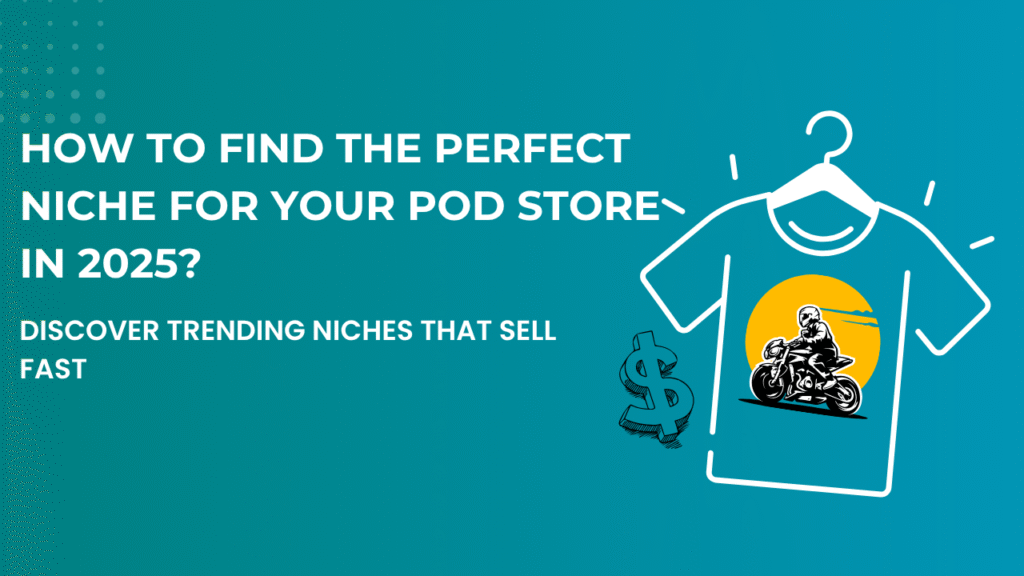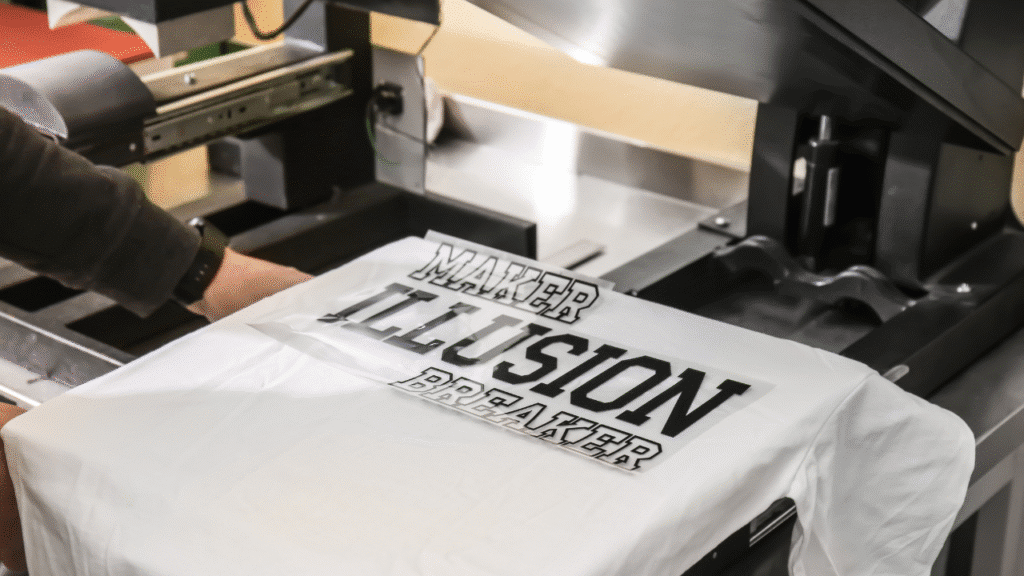How to Find the Perfect Niche for Your POD Store in 2025: A Beginner’s Guide to Print-on-Demand Success

“The riches are in the niches.” – this old-school marketing mantra still hits different, especially in the unpredictable world of Print-on-Demand (POD).
According to a 2024 report by Printify, POD sellers who focused on a defined niche saw 78% higher conversion rates than those with generic stores. Crazy, right? But honestly, it makes sense. When I first dipped my toes into POD, I had a bunch of random T-shirt designs – from gym quotes to sloth memes. Spoiler: barely anything sold. It wasn’t until I found my niche that things clicked.
Let’s dive into how to find the perfect niche for your POD store in 2025 – because this one decision can literally make or break your store.
What Is a POD Niche and Why Does It Matter?
In the world of POD, a niche is more than just a category or theme. It’s a specific audience with shared interests, passions, or problems – and your products are the solution (or at least, a fun expression of that identity).
A niche matters because you’re not trying to sell to everyone. That’s a surefire way to sell to no one. When you dial in on a specific group – like “vegan athletes” or “introverted book lovers” – your designs feel personal, your marketing gets easier, and your customers start to connect with your brand.
Why Picking a Niche Helps You Stand Out (Instead of Getting Lost)

Here’s the thing: anyone can launch a store with “funny quotes” or “cool graphic tees.” But those spaces are wildly saturated. Finding the perfect niche for your POD store in 2025 isn’t about jumping on fads – it’s about carving a space where you belong and building from there.
Here’s what you get when your niche is on point:
Examples of POD Niches That Work
Let’s talk niches that actually convert:
- Cat Lovers – Not just “pet owners,” but folks proudly ruled by their feline overlords. You can niche down even more by combining cats with a passion or lifestyle—think “yoga with cats,” “witchy cat moms,” “bookworms with black cats,” or even “introverted gamers and their lazy tabby sidekicks.” The more specific (and relatable), the better.
- Fitness Enthusiasts – Sub-niches here are gold: CrossFit moms, yoga bros, runners with dad bods.
- Travel Buffs – Folks who love wanderlust quotes, van life, and airport chaos.
- Book Nerds – Think sarcastic bookmarks, introvert shirts, and coffee-stained tote bags.
- Plant Parents – Millennials treating their monstera like royalty? Yup, it’s a thing.
Don’t just pick something because it sounds trendy. Choose something you get, something you’d talk about even if no one paid you.
Step-by-Step Guide: How to Find the Perfect Niche for Your POD Store in 2025

Finding your niche ain’t about spinning a wheel or guessing. There’s a process. Let’s walk through it:
1. Start With You
What are you into? What’s something you could talk about endlessly without Googling facts? Your niche doesn’t need to be your identity, but it helps if there’s some passion behind it.
- Hobbies: hiking, reading, gaming, cooking
- Personality traits: introverts, sarcasm lovers, deep thinkers
- Life stages: new moms, students, digital nomads
Side note: I once created a niche around remote workers during COVID lockdowns – “Zoom fatigue” shirts? Goldmine.
2. Do Market Research (Without Getting Bored to Death)
Here’s where tools come in clutch:
- Google Trends – Check if your niche is growing or dying.
- PodCs – A lifesaver for scanning Etsy, Amazon, and Redbubble trends in one place.
- Etsy – Type your niche + “shirt” or “mug” and analyze top sellers.
- PodSpy – Stalk (nicely) your competitors and what’s actually working for them.
Don’t just look at products – check out tag combos, review feedback, and design styles.
3. Validate the Demand (Before You Get Too Excited)
Okay, now that you’ve got some niche ideas – test ’em.
- Use platforms like Placeit or Canva to make mockup designs.
- Run quick polls on Reddit, Facebook groups, or Instagram Stories.
- Ask: Would you actually buy this? Would your friend?
If people shrug or scroll past, it’s not the one. If folks laugh, relate, or ask “where can I get this?” – you’re on to something.
4. Size Up the Competition (But Don’t Panic)
A little competition is fine – it means people are buying. But too much? Red flag.
Look for:
- How many top sellers dominate the niche
- Is there a unique angle you can add (style, humor, language)?
- Are you bringing something fresh to the table?
Don’t copy – differentiate. Maybe you go hyper-local (“Desi cat dads” instead of just “cat dads”) or mash up interests (“Fitness + Gaming” = “Squat. Respawn. Repeat.” Or “Leveling Up IRL”).
5. Run a Small Launch and Gather Real Feedback
Before going full throttle, drop a micro-collection.
- Test with 5–10 designs
- Sell on Etsy, your own Shopify, or even Instagram
- Collect buyer feedback (and keep improving)
Let data guide you, not just your gut.
Popular Niche Ideas for POD in 2025 (Spoiler: Some Are Weird But Profitable)
Here’s a quick brain-dump of ideas that are blowing up (or quietly making bank):
- Neurodivergent Empowerment – ADHD, autism, mental health awareness with honest and stylish messaging
- Cottagecore + Nature Aesthetics – Think frogs, mushrooms, forest vibes
- Spiritual Entrepreneurs – Tarot readers, crystal lovers, chakra healers
- Blue-Collar Pride – Mechanics, farmers, truck drivers – all underrepresented but loyal as heck
- Hyper-Local Pride – State or city-based inside jokes, slang, or memes You don’t need to reinvent the wheel – just know who you’re designing for.
Mistakes to Avoid When Choosing a Niche (Yeah, I’ve Made a Few)

Don’t fall for these traps:
- Too Broad – “Funny t-shirts” or “motivational quotes” is not a niche.
- No Audience – Choosing something you love but no one else does. (RIP, my medieval potato meme store)
- Copycatting – Mimicking successful shops without a twist.
- Ignoring Trends – Jumping in too late or missing rising patterns.
- Analysis Paralysis – Overthinking for weeks without taking action.
Seriously, progress > perfection.
Also read:- Pros and Cons of Print on Demand: Is it the Right Business Model for You?
Final Tips for Long-Term Niche Success
Let’s wrap this part with some real tips to stick with your niche for the long haul:
Experiment, Then Iterate.
Test, tweak, and test again. Early feedback is gold – use it to refine your designs, voice, and product mix.
Build a Community.
Email lists, social media, niche forums – start engaging and giving value before asking for a sale.
Don’t Get Stale.
Trends shift. Monitor them using tools like PodSpy or Etsy search volumes. Keep adapting without losing your core identity.
Treat It Like a Brand.
Even if you’re just one person behind a laptop, present your POD store like a legit brand. Consistency wins trust.
Conclusion: Go Deep, Not Wide
Finding the perfect niche for your POD store in 2025 isn’t a magical moment – it’s a mix of gut instinct, real research, and trial and error. But once you hit that sweet spot? Everything starts feeling easier. You’ll attract the right people, create stuff you’re proud of, and actually start making sales that don’t feel like a fluke.
So, what’s your niche going to be? Don’t overthink it. Start where you are. Test something small. Watch what clicks.
FAQ: Top 10 Digital Products to Sell Online for Passive Income
A POD niche is a specific audience or group of people who share common interests, values, or lifestyles. Instead of selling to everyone, you focus on creating designs for that specific group—like cat lovers, gamers, or yoga moms—which helps you connect better and sell more effectively.
Yes, that’s actually one of the best strategies. Combining two interests (like fitness + gaming or cats + books) helps you stand out. Just make sure the combination makes sense and connects with a real audience.
Totally. In fact, many successful POD sellers evolve their niche over time based on sales, feedback, or changing interests. Start focused, but stay flexible.
If you’re just starting, stick to one clear niche. This helps you build a brand and attract the right audience. Once you’re established, you can explore sub-niches or create separate stores for different audiences.
Not necessarily, but it helps. If you understand your audience’s language, problems, and humor, your designs will naturally resonate better. If you’re not part of the niche, do deeper research and validate your ideas before launching.
That’s okay, Pivoting is part of the process. Use the feedback and data to test new ideas, adjust your targeting, or evolve your current niche. Many successful POD sellers refine their niche over time.
Choosing the right niche helps you stand out in a crowded POD market. It allows you to create products that feel personal to a specific group, leading to higher engagement, loyal customers, and better sales conversions.